Breckwell P23FSA, P23I, P23FSL User Manual 2

TRADITION SERIES P23
|
|
|
|
|
P23FSL |
P23I |
|
P23FSA |
|
OWNER’S MANUAL
∙WARNING: If your appliance is not properly installed a house fire may result. For your safety, follow the installation directions. Contact local building or fire officials about restrictions and installation inspection requirements in your area.
∙PLEASE read this entire manual before installation and use of this pellet fuel-burning room heater. Failure to follow these instructions could result in property damage, bodily injury, or even death.
∙Save these instructions.
PROFESSIONAL INSTALLATION IS HIGHLY RECOMMENDED
Manufactured by Breckwell Hearth Products Eugene, Oregon
Grand Prairie, Texas
ãBRECKWELL HEARTH PRODUCTS
C-L-068 8/03

2 |
INTRODUCTION |
Thank you for purchasing the Breckwell Pellet Burning Stove. You are now prepared to burn wood in the most efficient, convenient way possible. To achieve the safest, most efficient and most enjoyable performance from your stove, you must do three things: 1) Install it properly; 2) Operate it correctly; and 3) Maintain it regularly. The purpose of this manual is to help you do all three.
PLEASE read this entire manual before installation and use of this pellet fuel-burning room heater. Failure to follow these instructions could result in property damage, bodily injury or even death.
Keep this manual handy for future reference.
Your Breckwell P23 comes as a fireplace insert or as a freestanding stove with legs or a pedestal.
This stove has been independently tested to ASTM E1509-95 Standard Specification for Room Heaters, Pellet Fuel Burning Type 1, UL 1482-1998 Standard for Solid Fuel Room Heaters, Oregon Administrative Rules for Mobile Homes (814-23-900 through 814-23-909) and Installation as a Stove Heater.
This pellet stove, when installed, must be electrically grounded in accordance with local codes, or in the absence of local codes, with the National Electrical Code, ANSI/NFPA 70.
This appliance is designed specifically for use only with pelletized wood. It is designed for residential installation according to current national and local building codes as a freestanding room heater. It is also approved as a mobile home heater which is designed for connection to an outside combustion air source.
The stove will not operate using natural draft or without a power source for the blower systems and fuel feed system and must not be burned with any type of coal (see PROPER FUEL).
This stove is designed to provide the optimum proportions of fuel and air to the fire in order to burn free of smoke and soot. Any blockage of the air supply to or from the stove will seriously degrade its performance and will be evidenced by a smoking exhaust and a sooting window. For best operation the ash content of the pellet fuel should be less than 1% and the calorific value approximately 8200 BTU/LB. Avoid high ash content fuels because this will rapidly fill up the burn pot and eventually cut off the combustion air supply.
Commercial and industrial installations of Breckwell Pellet Stoves should not be used since operational control is often not well managed in these settings.
IMPORTANT INFORMATION |
|
MAIL YOUR WARRANTY CARD TODAY |
|
|
To receive full warranty coverage, you will |
Model: _____P23___________________ |
|
need to show evidence of the date you |
Style: ____________________________ |
|
purchased your stove. We suggest that |
Serial Number:_____________________ |
|
you attach your sales invoice to this page, |
Purchase Date: ____________________ |
|
and fill in the form on the left, so that you |
Purchased From:___________________ |
|
will have all the information you need in |
___________________ |
|
one place should the need for service or |
___________________ |
|
information occur. |
|
|
|
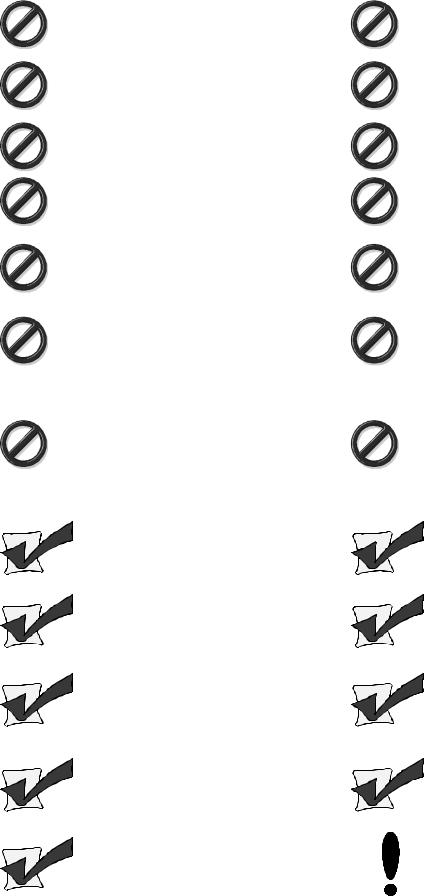
SAFETY PRECAUTIONS |
3 |
∙Do not operate your stove if you smell smoke coming from it. Turn it off, monitor it, and call your dealer.
∙Never use gasoline, gasolinetype lantern fuel, kerosene, charcoal lighter fluid, or similar liquids to start or “freshen up” a fire in this stove. Keep all such liquids well away from the stove while in use.
∙Never block free airflow through the open vents of the stove.
∙Never try to repair or replace any part of the stove unless instructions are given in this manual. All other work should be done by a trained technician.
∙The stove will not operate during a power outage. If an outage does occur, check the stove for smoke spillage and open a window if any smoke spills into the room.
∙Disconnect the power cord before performing any maintenance or repairs on the stove.
NOTE: Turning the stove “off” does not disconnect all power from the stove.
∙Do not unplug the stove if you suspect a malfunction. Turn the stove off, periodically inspect it, and call your dealer.
∙Contact your local building officials to obtain a permit and information on any installation restrictions or inspection requirements in your area. Notify your insurance company of this stove as well.
∙This unit must be properly installed to prevent the possibility of a house fire. The instructions must be strictly adhered to. Do not use makeshift methods or compromise in the installation.
∙Allow the stove to cool before carrying out any maintenance or cleaning. Ashes must be disposed in a metal container with a tight lid and placed on a no combustible surface well away from the home structure.
∙This stove must be connected to a standard 120 V., 60 Hz grounded electrical outlet. Do not use an adapter plug or sever the grounding plug. Do not route the electrical cord underneath, in front of, or over the stove.
∙The exhaust system should be checked, at a minimum, at least twice a year for any build up of soot or creosote.
∙Keep foreign objects out of the
hopper.
∙Do not throw this manual away. This manual has important operating and maintenance instructions that you will need at a later time. Always follow the instructions in this manual.
∙Do not place clothing or other flammable items on or near the stove.
∙The viewing door must be closed and latched during operation.
∙Do not operate the stove if the flame becomes dark and sooty or if the burnpot overfills with pellets. Turn the stove off, periodically inspect it, and call your dealer.
∙Do not touch the hot surfaces of the heater. Educate all children of the danger of a high temperature stove. Young children should be supervised when they are in the same room as the stove.
∙If the stove is installed in a room without air conditioning, or in an area where direct sunlight can shine on the unit, it is possible this can cause the temperature of the stove to rise to operational levels; one of the sensors could then make the stove start on its own. It is recommended that the stove be unplugged when not in use for extended amounts of time (i.e. during the summer months).
∙The exhaust system must be completely airtight and properly installed. The pellet vent joints must be sealed with RTV 500°F. (260°C.) silicone sealant, and with UL- 181-AP foil tape.
∙Your stove requires periodic maintenance and cleaning. Failure to maintain your stove may lead to smoke spillage in your home.
∙This stove is designed and approved for pelletized wood fuel only. Any other type of fuel burned in this heater will void the warranty and safety listing.
∙When installed in a mobile home, the stove must be bolted to the floor, have outside air, and NOT BE INSTALLED IN A BEDROOM (Per H.U.D. requirements). Check with local building officials.
∙Breckwell Hearth Products grants no warranty, implied or stated, for the installation or maintenance of your stove, and assumes no responsibility of any consequential damage(s).
4 |
TABLE OF CONTENTS |
INTRODUCTION --------------------------------------------------------------------------------------------- |
2 |
SAFETY PRECAUTIONS ---------------------------------------------------------------------------------- |
3 |
SPECIFICATIONS ------------------------------------------------------------------------------------------- |
5 |
INSTALLATION --------------------------------------------------------------------------------------------- |
5 |
Preparation ----------------------------------------------------------------------------------------- |
5 |
Clearances ----------------------------------------------------------------------------------------- |
5 |
Combustion Air Supply -------------------------------------------------------------------------- |
6 |
When Outside Air Is Not Used ----------------------------------------------------------------- |
6 |
Venting ----------------------------------------------------------------------------------------------- |
6 |
Freestanding Installations ---------------------------------------------------------------------- |
7 |
Insert Installations -------------------------------------------------------------------------------- |
11 |
Electrical Installation ------------------------------------------------------------------------------ |
14 |
Special Mobil Home Requirements ---------------------------------------------------------- |
14 |
OPERATION --------------------------------------------------------------------------------------------------- |
15 |
Proper Fuel ----------------------------------------------------------------------------------------- |
15 |
Pre-Start-Up Check ------------------------------------------------------------------------------- |
15 |
Building a Fire ------------------------------------------------------------------------------------- |
15 |
The HotRod™ Automatic Fire Starter -------------------------------------------------------- |
15 |
Panel Controls ------------------------------------------------------------------------------------- |
15 |
Opening Door -------------------------------------------------------------------------------------- |
16 |
Room Air Fan -------------------------------------------------------------------------------------- |
16 |
Re-Starting a Warm Stove ---------------------------------------------------------------------- |
16 |
If Stove Runs Out Of Pellets -------------------------------------------------------------------- |
17 |
Damper Control ------------------------------------------------------------------------------------ |
17 |
Refueling --------------------------------------------------------------------------------------------- |
17 |
Breckwell Maintenance Tool -------------------------------------------------------------------- |
17 |
Shutdown Procedure ----------------------------------------------------------------------------- |
17 |
Safety Features ------------------------------------------------------------------------------------ |
17 |
Optional Thermostat ------------------------------------------------------------------------------ |
18 |
Thermostat Installation -------------------------------------------------------------------------- |
18 |
(Please Read This) Operating Safety Precautions -------------------------------------- |
19 |
MAINTENANCE ---------------------------------------------------------------------------------------------- |
20 |
Ash Removal ---------------------------------------------------------------------------------------- |
20 |
Ash Disposal - Freestanding ------------------------------------------------------------------- |
20 |
Ash Disposal - Insert ------------------------------------------------------------------------------ |
20 |
Vacuum Use ---------------------------------------------------------------------------------------- |
21 |
Cleaning ---------------------------------------------------------------------------------------------- |
21 |
Blowers ---------------------------------------------------------------------------------------------- |
21 |
Chimney Cleaning -------------------------------------------------------------------------------- |
22 |
Recommended Maintenance Schedule ----------------------------------------------------- |
22 |
Removal & Replacement of Broken Door Glass ------------------------------------------ |
22 |
TROUBLE SHOOTING GUIDE -------------------------------------------------------------------------- |
23 |
Smoke Smell or Soot Build-Up ---------------------------------------------------------------- |
28 |
ELECTRICAL DIAGRAM --------------------------------------------------------------------------------- |
29 |
REPLACEMENT PARTS LIST -------------------------------------------------------------------------- |
30 |

INSTALLATION |
5 |
|
|
|
SPECIFICATIONS
FREESTANDING:
Width: 22 ½”
Height: 29” (with pedestal), 28 ½” (with legs) Depth: 27” (excluding ash lip)
Weight: 210 lbs.
Pedestal: 40 lbs. Legs: 13 lbs.
Flue size: 3” or 4”
Hopper Capacity: Up to 60 lbs.
(this can vary widely depending on pellet size, length, and diameter) EPA status: exempt
Burn time: 1 lb. to 5 lbs. per hour BTU range: 8,200 to 47,000
Approved installations: mobile home, alcove, conventional
FIREPLACE INSERT:
Width: 21” (With flashing: 42”) Height: 20” (With flashing: 30” or 32”)
(depending on which size of flashing used) Depth: 22 ¾”
In fireplace: 11 ½” Weight: 185 lbs.
Flashing: 13 lbs. Flue size: 3” or 4”
Hopper Capacity: Up to 60 lbs.
(this can vary widely depending on pellet size, length, and diameter) EPA status: exempt
Burn time: 1 lb. to 5 lbs. per hour BTU range: 8,200 to 47,000
Approved installations: zero-clearance, masonry, as a built-in
PREPARATION
Factory packaging must be removed, and some minor assembly work is required prior to installation. Access to the rear of the stove is necessary.
The circuit board/control panel must be unpacked and installed in the side flashing on the insert. (See installation instructions provided with the circuit board)
NOTE: Normally, your dealer will perform these functions.
CLEARANCES
The Breckwell P23 Freestanding has been tested and listed for installation in residential, mobile home and alcove applications.
The P23 Insert is approved for installation into code complying masonry fireplaces.
The P23 Insert is also approved for use in listed factory built fireplaces (UL 127) and standard residential built-ins (see As A Built-In Fireplace), including Mobile Home built-in installations, of the following description: all brands at least 33” wide and 20 ½” high.
FLOOR PROTECTION: Freestanding installations, minimum 22” wide by 31” deep. The stove must be placed on a continuous (grouted joints) noncombustible material such as ceramic tile, cement board, brick, 3/8” millboard or equivalent, or other approved or listed material suited for floor protection. NOTE: ceramic tile, or any tile, requires a continuous sheet beneath to prevent the possibility of embers falling through to the combustible floor if cracks or separation should occur in the finished surface, this would include floor protection for Built-in raised hearths. Check local codes for approved alternatives.
Clearances are measured from the sides, back and face (door opening) or stove body (refer to fig. 4).
DO NOT USE MAKESHIFT MATERIALS OR COMPROMISES IN THE INSTALLATION OF THIS UNIT.
INSTALL VENT WITH CLEARANCES SPECIFIED BY THE VENT MANUFACTURER.
FIGURE 1
FIGURE 2
FIGURE 3
FLOOR PROTECTION
FIGURE 4
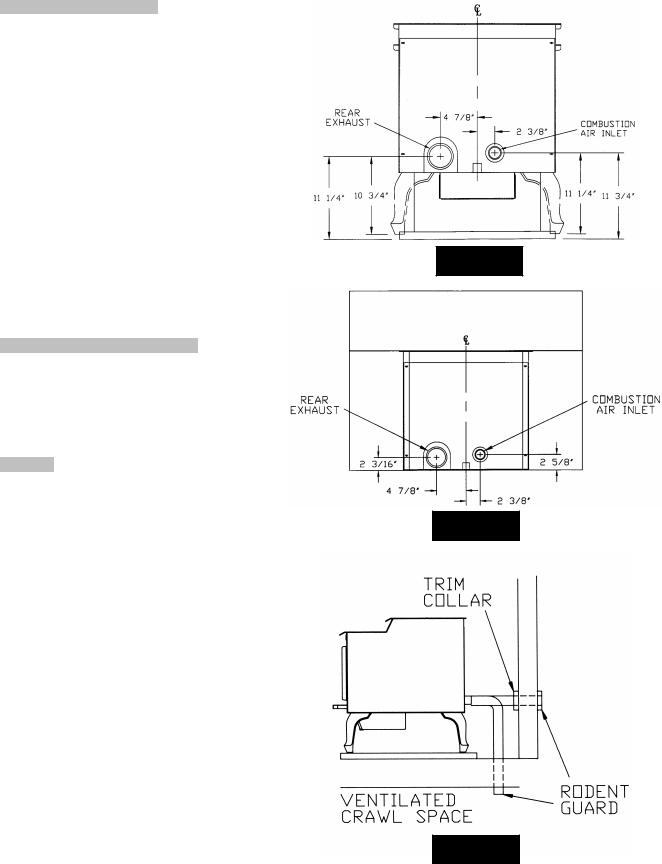
6 |
INSTALLATION |
COMBUSTION AIR SUPPLY
For a mobile home installation the stove must be connected to an outside source of combustion air. A 2” inside diameter metallic pipe, either flexible or rigid, may be attached to the inlet at the stove’s rear (refer to figures 5 and 6). A rodent guard (minimum ¼” wire mesh)/wind hood must be used at the terminus (refer to figure 7). All connections must be secured and airtight by either using the appropriately sized hose clamp and/or UL-181-AP foil tape.
For mobile home installations only: 2” inside diameter pipe may be used for the first 5 feet of combustion air supply run. From 5 to 10 feet use 2 ¾” inside diameter pipe. No combustion air supply may exceed 10 feet.
Sources of Outside Combustion Air
a.In fireplaces
∙Chimney top.
∙Ash clean out door.
b.For freestanding installations
∙A hole in floor near stove rear terminating only in a ventilated crawl space.
∙A hole in the wall behind the stove.
WHEN OUTSIDE AIR IS NOT USED
If outside air is not used, it is important that combustion air is easily available to the air inlet. A closeable outside air register can be used in tightly insulated homes. In insert installations, flashing vents should not be restricted. The flashing should not necessarily seal the fireplace face.
VENTING
The Breckwell P23 Freestanding is certified for use with listed TYPE L-Vent, 3” or 4” diameter in size. The stove was tested with Simpson Duravent brand. Class “A” chimney is not required. Refer to the instructions provided by the vent manufacturer, especially when passing through a wall, ceiling or roof.
This is a pressurized exhaust system. All vent connector joints must be sealed with 500°F (260°C) RTV silicone sealant to ensure consistent performance and avoid smoke spillage. All horizontal connector joints must be sealed with UL-181-AP foil tape. We recommend that all vertical vent connector joints be secured with a minimum of 3 screws.
DO NOT CONNECT THIS UNIT TO A CHIMNEY FLUE SERVING ANOTHER APPLIANCE.
DO NOT INSTALL A FLUE DAMPER IN THE EXHAUST VENTING SYSTEM OF THIS UNIT.
INSTALL VENT AT CLEARANCES SPECIFIED BY THE VENT MANUFACTURER.
FIGURE 5
FIGURE 6
FIGURE 7
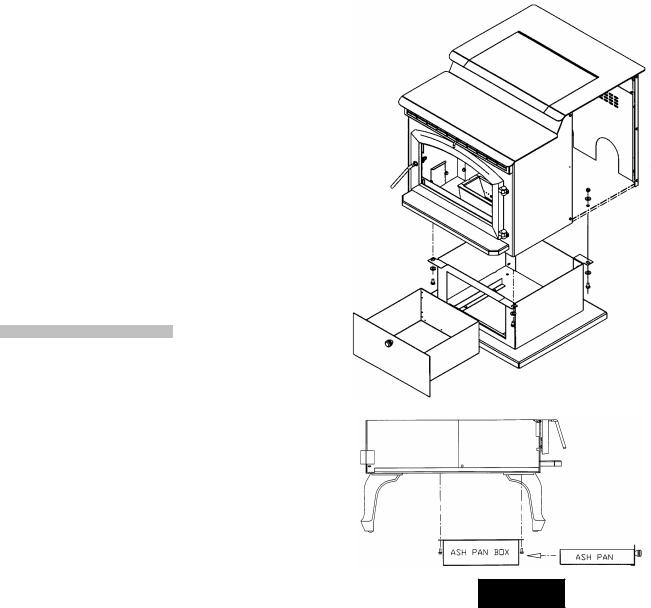
INSTALLATION |
7 |
|
|
Equivalent Vent Length (EVL)
The longer the run of pipe in your installation (both with insert and freestanding models), the more restriction there is in the system. Therefore, larger diameter pipe should be used.
∙Use 4” pipe if you have more than 15 feet of equivalent vent length.
∙Horizontal runs shall not exceed 10 feet of EVL.
∙Recommended vertical runs to be a minimum of 8 feet.
∙To calculate EVL, use the following conversions:
90º elbow or “T” |
= 5 equivalent feet |
45º elbow |
= 3 equivalent feet |
Horizontal Pipe Run |
= 1 equivalent foot per actual foot |
Vertical Pipe Run |
= 0.5 equivalent foot per actual foot |
NOTE: At altitudes above 3,000 feet, we suggest the use of 4” diameter vent at an EVL of 7 feet or more.
FREESTANDING INSTALLATIONS
A.ASSEMBLING PEDESTAL OR LEG SET
If using a pedestal, follow the instructions inside the Breckwell P23 Pedestal w/ Ashpan Part # A-P23-PNEW
(Refer to figure 8).
If using cast legs, follow the instructions inside the Breckwell P23
Leg Set w/ Ashpan Part # A-CGL-NEW or # A-CL-NEW.
Legs are installed by using the four bolts provided in the kit into the four holes under the stove at each corner, thread on nuts from the top and tighten. Make sure to save the hole plugs.
NOTE: If converting from legs to pedestal the hole plugs must be installed in the unused holes.
FIGURE 8
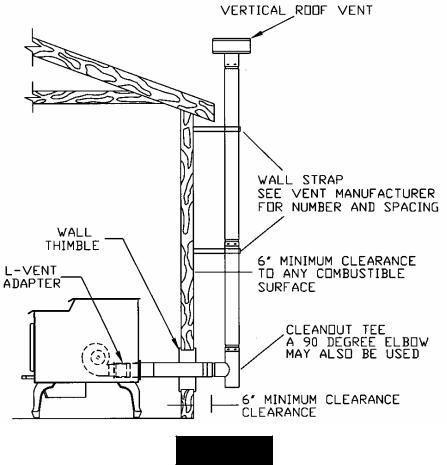
8 |
INSTALLATION |
|
|
B.HORIZONTALLY THROUGH WALL
(refer to Figure 9)
NOTE: Follow L-Vent chimney manufacturer’s instructions.
1.Position stove, adhering to clearances shown in Figures 1 & 2.
2.Locate position of hole in wall; directly behind stove exhaust vent (refer to figure 5).
3.Always maintain 3” clearance from combustible materials.
4.Install L-Vent wall thimble per L-Vent manufacturer’s instructions.
5.Attach enough piping to penetrate and extend at least 6” beyond exterior walls. A minimum 8-foot vertical pipe run is suggested where possible to reduce the possibility of smoke spillage in the event of a loss of negative pressure.
6.Attach cap and seal outside wall thimbles with non-hardening waterproof mastic.
7.Termination should not be located so that hot exhaust gases can ignite trees, shrubs, or grasses or be a hazard to children. Exhaust gases can reach temperatures of 500ºF and cause serious burns if touched.
FIGURE 9
Locate terminations: a) not less than 3 feet above any forced air inlet located within 10 feet; b) not less than 4 feet below or horizontally from, or one foot above, any door, window or gravity air inlet into any building; c) not less than two feet from an adjacent building and not less than 7 feet above grade when located adjacent to a public walkway. Mobile home installations must use a spark arrester.
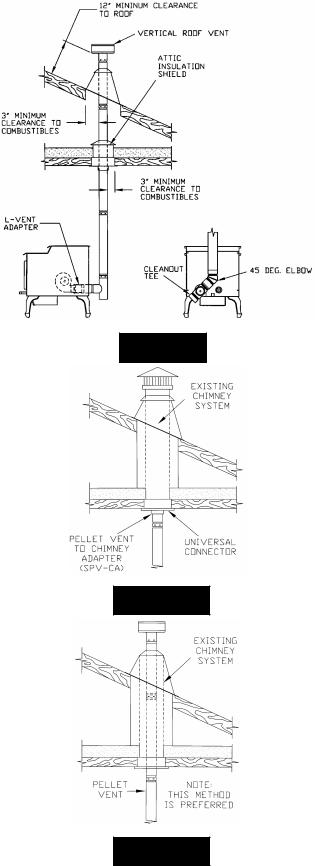
INSTALLATION |
9 |
|
|
|
B.VERTICALLY WITH NEW CHIMNEY SYSTEM (Refer to Figure 10)
NOTE: Follow L-Vent chimney manufacturer’s instructions.
OPTION: To achieve a center vertical installation a 45º elbow and a clean-out tee can be used to offset the pipe from the exhaust outlet to the rear center of the stove.
OPTION: Install L-Vent elbow in place of clean-out tee. Locate stove. Drop plumb bob to center of tee outlet, mark point on ceiling. Install ceiling support and L-Vent pipe per L-Vent manufacturer’s instructions.
1.Always maintain 3” clearance from combustible materials. When passing through additional floors or ceilings, always install firestop spacer.
2.After lining up for hole in roof, cut either around or square hole in roof, always 3” larger all the way around pipe. Install upper edge and sides of flashing under roofing materials, nail to the roof along upper edge. Do not nail lower edge. Seal nail heads with non-hardening waterproof mastic.
3.Apply non-hardening, waterproof mastic where the storm collar will meet the vent and flashing. Slide storm collar down until it sits on the flashing. Seal and install cap. Mobile home installations must use a spark arrester.
C.VERTICALLY INTO EXISTING CHIMNEY SYSTEM
Adapters are available to adapt from 3” L-Vent to 6” or 8” Class-A chimney. (Figure 11a)
As an alternative, 3” or 4” L-Vent can be run inside existing chimney to termination. (Figure 11b)
This is the preferred method.
Follow guidelines for equivalent vent length.
FIGURE 10
FIGURE 11a
FIGURE 11b
